Contract Law Assignment: Offer, Acceptance, and Contract Formation
VerifiedAdded on 2021/06/18
|6
|1954
|32
Homework Assignment
AI Summary
This assignment analyzes the formation of a contract, focusing on the essential elements of offer and acceptance. It begins by defining a contract and its key components, including offer, acceptance, consideration, and intention to create legal relations. The paper delves into the specifics of an offer, differentiating it from an invitation to treat, and explores the intention of parties involved. The assignment uses case laws like Carlill v Carbolic Smoke Ball Co and Pharmaceutical Society of Great Britain v Boots to illustrate these concepts. It then examines acceptance, emphasizing its unequivocal nature and the requirement for communication. The assignment outlines the rules of acceptance and the modes of communication, including the postal rule and the application of these rules to modern communication methods like fax and email, supported by cases like Entores v. Miles Far East Corporation and NM Superannuation Pty Limited v. Hughes. The assignment then applies these principles to a case study involving Melvyn and David, concluding that a valid contract was formed, and Melvyn could not cancel it after acceptance.
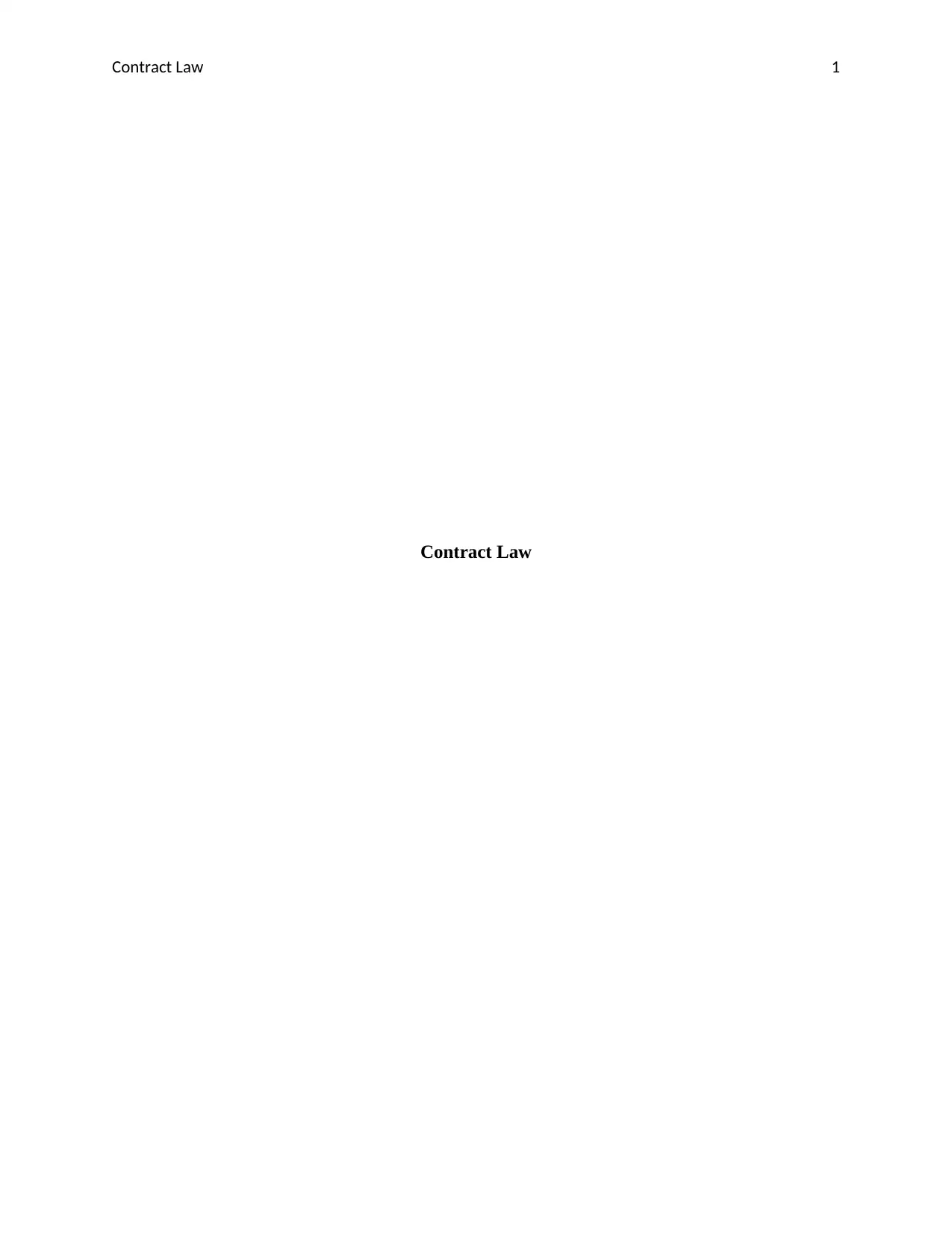
Contract Law 1
Contract Law
Contract Law
Paraphrase This Document
Need a fresh take? Get an instant paraphrase of this document with our AI Paraphraser
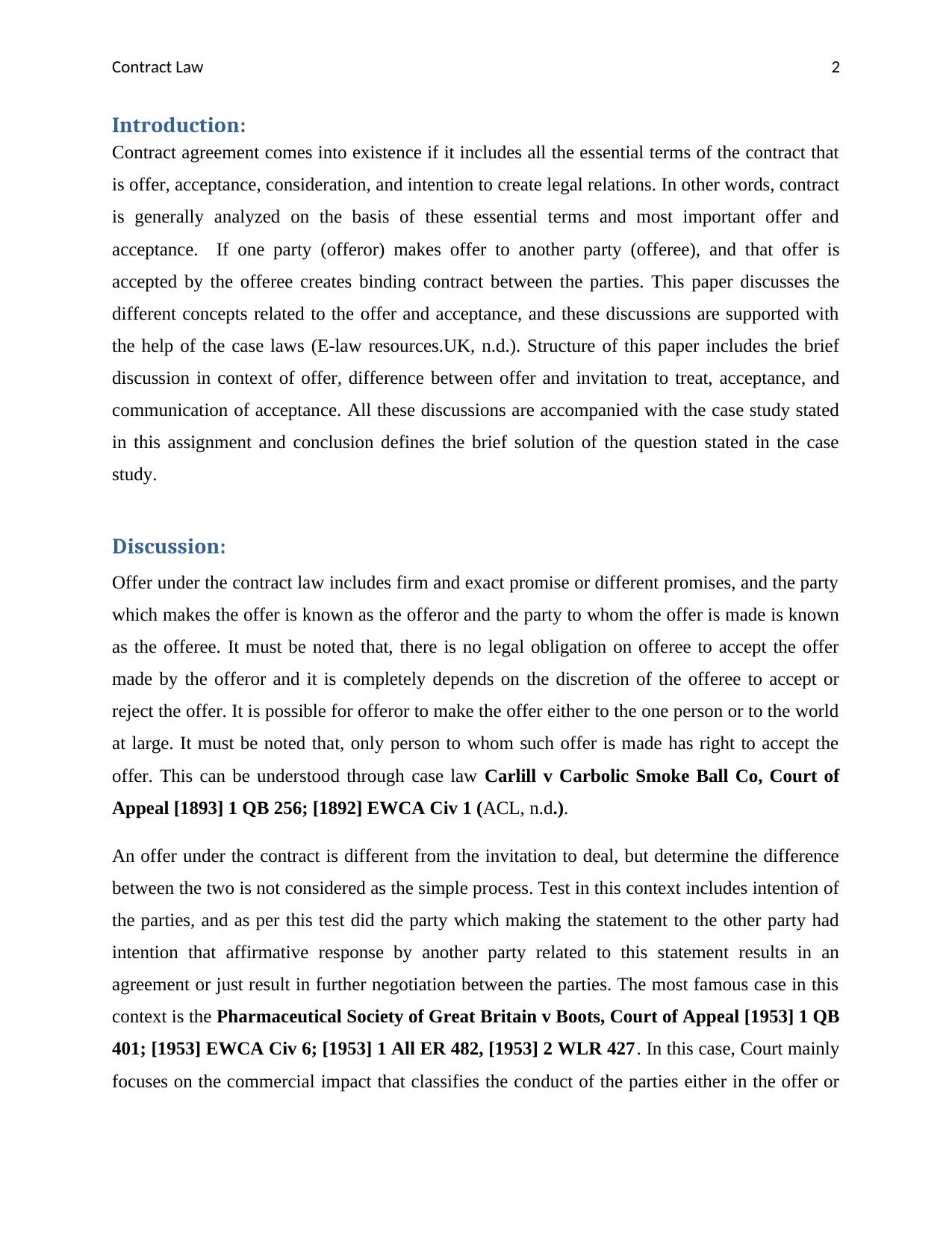
Contract Law 2
Introduction:
Contract agreement comes into existence if it includes all the essential terms of the contract that
is offer, acceptance, consideration, and intention to create legal relations. In other words, contract
is generally analyzed on the basis of these essential terms and most important offer and
acceptance. If one party (offeror) makes offer to another party (offeree), and that offer is
accepted by the offeree creates binding contract between the parties. This paper discusses the
different concepts related to the offer and acceptance, and these discussions are supported with
the help of the case laws (E-law resources.UK, n.d.). Structure of this paper includes the brief
discussion in context of offer, difference between offer and invitation to treat, acceptance, and
communication of acceptance. All these discussions are accompanied with the case study stated
in this assignment and conclusion defines the brief solution of the question stated in the case
study.
Discussion:
Offer under the contract law includes firm and exact promise or different promises, and the party
which makes the offer is known as the offeror and the party to whom the offer is made is known
as the offeree. It must be noted that, there is no legal obligation on offeree to accept the offer
made by the offeror and it is completely depends on the discretion of the offeree to accept or
reject the offer. It is possible for offeror to make the offer either to the one person or to the world
at large. It must be noted that, only person to whom such offer is made has right to accept the
offer. This can be understood through case law Carlill v Carbolic Smoke Ball Co, Court of
Appeal [1893] 1 QB 256; [1892] EWCA Civ 1 (ACL, n.d.).
An offer under the contract is different from the invitation to deal, but determine the difference
between the two is not considered as the simple process. Test in this context includes intention of
the parties, and as per this test did the party which making the statement to the other party had
intention that affirmative response by another party related to this statement results in an
agreement or just result in further negotiation between the parties. The most famous case in this
context is the Pharmaceutical Society of Great Britain v Boots, Court of Appeal [1953] 1 QB
401; [1953] EWCA Civ 6; [1953] 1 All ER 482, [1953] 2 WLR 427. In this case, Court mainly
focuses on the commercial impact that classifies the conduct of the parties either in the offer or
Introduction:
Contract agreement comes into existence if it includes all the essential terms of the contract that
is offer, acceptance, consideration, and intention to create legal relations. In other words, contract
is generally analyzed on the basis of these essential terms and most important offer and
acceptance. If one party (offeror) makes offer to another party (offeree), and that offer is
accepted by the offeree creates binding contract between the parties. This paper discusses the
different concepts related to the offer and acceptance, and these discussions are supported with
the help of the case laws (E-law resources.UK, n.d.). Structure of this paper includes the brief
discussion in context of offer, difference between offer and invitation to treat, acceptance, and
communication of acceptance. All these discussions are accompanied with the case study stated
in this assignment and conclusion defines the brief solution of the question stated in the case
study.
Discussion:
Offer under the contract law includes firm and exact promise or different promises, and the party
which makes the offer is known as the offeror and the party to whom the offer is made is known
as the offeree. It must be noted that, there is no legal obligation on offeree to accept the offer
made by the offeror and it is completely depends on the discretion of the offeree to accept or
reject the offer. It is possible for offeror to make the offer either to the one person or to the world
at large. It must be noted that, only person to whom such offer is made has right to accept the
offer. This can be understood through case law Carlill v Carbolic Smoke Ball Co, Court of
Appeal [1893] 1 QB 256; [1892] EWCA Civ 1 (ACL, n.d.).
An offer under the contract is different from the invitation to deal, but determine the difference
between the two is not considered as the simple process. Test in this context includes intention of
the parties, and as per this test did the party which making the statement to the other party had
intention that affirmative response by another party related to this statement results in an
agreement or just result in further negotiation between the parties. The most famous case in this
context is the Pharmaceutical Society of Great Britain v Boots, Court of Appeal [1953] 1 QB
401; [1953] EWCA Civ 6; [1953] 1 All ER 482, [1953] 2 WLR 427. In this case, Court mainly
focuses on the commercial impact that classifies the conduct of the parties either in the offer or
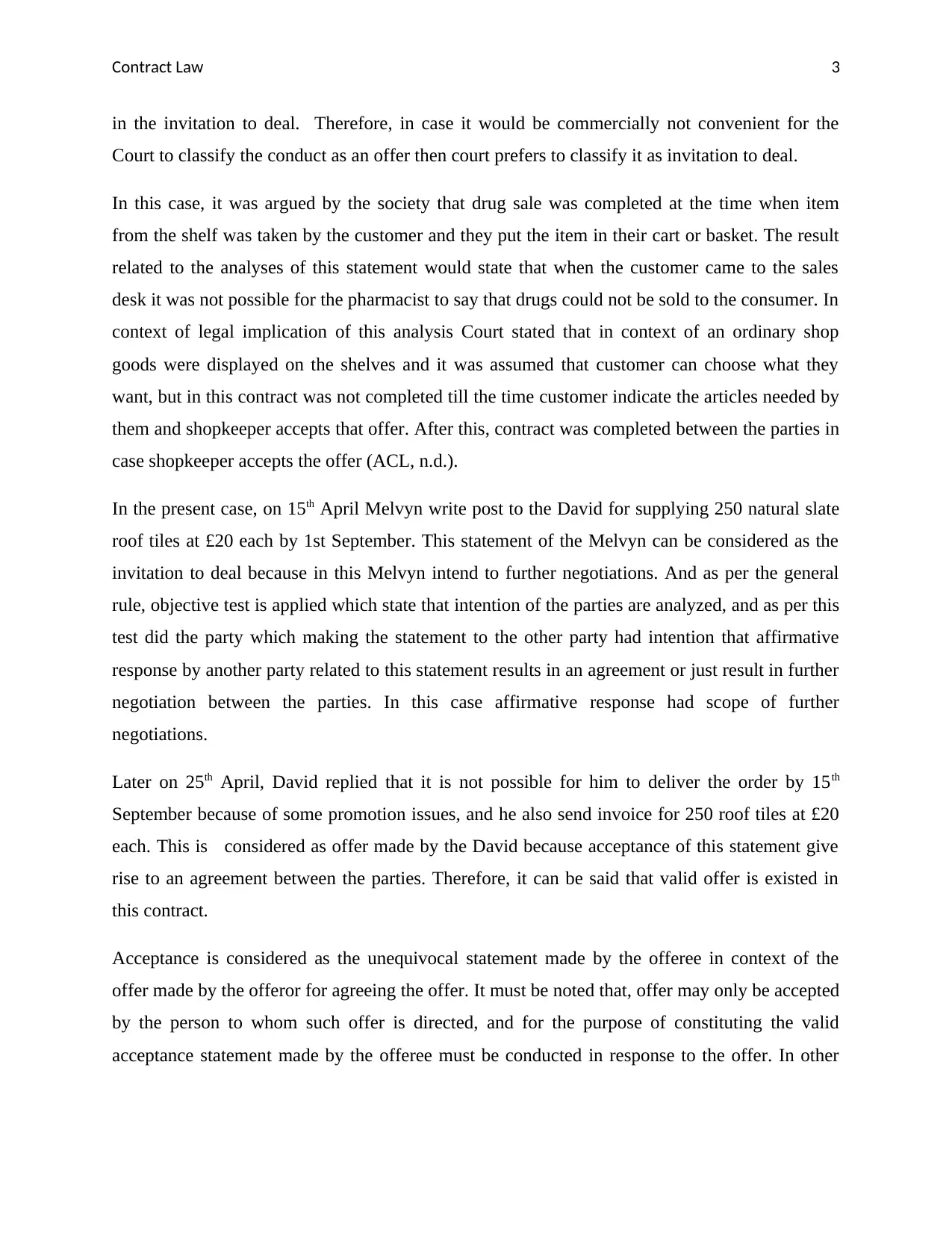
Contract Law 3
in the invitation to deal. Therefore, in case it would be commercially not convenient for the
Court to classify the conduct as an offer then court prefers to classify it as invitation to deal.
In this case, it was argued by the society that drug sale was completed at the time when item
from the shelf was taken by the customer and they put the item in their cart or basket. The result
related to the analyses of this statement would state that when the customer came to the sales
desk it was not possible for the pharmacist to say that drugs could not be sold to the consumer. In
context of legal implication of this analysis Court stated that in context of an ordinary shop
goods were displayed on the shelves and it was assumed that customer can choose what they
want, but in this contract was not completed till the time customer indicate the articles needed by
them and shopkeeper accepts that offer. After this, contract was completed between the parties in
case shopkeeper accepts the offer (ACL, n.d.).
In the present case, on 15th April Melvyn write post to the David for supplying 250 natural slate
roof tiles at £20 each by 1st September. This statement of the Melvyn can be considered as the
invitation to deal because in this Melvyn intend to further negotiations. And as per the general
rule, objective test is applied which state that intention of the parties are analyzed, and as per this
test did the party which making the statement to the other party had intention that affirmative
response by another party related to this statement results in an agreement or just result in further
negotiation between the parties. In this case affirmative response had scope of further
negotiations.
Later on 25th April, David replied that it is not possible for him to deliver the order by 15th
September because of some promotion issues, and he also send invoice for 250 roof tiles at £20
each. This is considered as offer made by the David because acceptance of this statement give
rise to an agreement between the parties. Therefore, it can be said that valid offer is existed in
this contract.
Acceptance is considered as the unequivocal statement made by the offeree in context of the
offer made by the offeror for agreeing the offer. It must be noted that, offer may only be accepted
by the person to whom such offer is directed, and for the purpose of constituting the valid
acceptance statement made by the offeree must be conducted in response to the offer. In other
in the invitation to deal. Therefore, in case it would be commercially not convenient for the
Court to classify the conduct as an offer then court prefers to classify it as invitation to deal.
In this case, it was argued by the society that drug sale was completed at the time when item
from the shelf was taken by the customer and they put the item in their cart or basket. The result
related to the analyses of this statement would state that when the customer came to the sales
desk it was not possible for the pharmacist to say that drugs could not be sold to the consumer. In
context of legal implication of this analysis Court stated that in context of an ordinary shop
goods were displayed on the shelves and it was assumed that customer can choose what they
want, but in this contract was not completed till the time customer indicate the articles needed by
them and shopkeeper accepts that offer. After this, contract was completed between the parties in
case shopkeeper accepts the offer (ACL, n.d.).
In the present case, on 15th April Melvyn write post to the David for supplying 250 natural slate
roof tiles at £20 each by 1st September. This statement of the Melvyn can be considered as the
invitation to deal because in this Melvyn intend to further negotiations. And as per the general
rule, objective test is applied which state that intention of the parties are analyzed, and as per this
test did the party which making the statement to the other party had intention that affirmative
response by another party related to this statement results in an agreement or just result in further
negotiation between the parties. In this case affirmative response had scope of further
negotiations.
Later on 25th April, David replied that it is not possible for him to deliver the order by 15th
September because of some promotion issues, and he also send invoice for 250 roof tiles at £20
each. This is considered as offer made by the David because acceptance of this statement give
rise to an agreement between the parties. Therefore, it can be said that valid offer is existed in
this contract.
Acceptance is considered as the unequivocal statement made by the offeree in context of the
offer made by the offeror for agreeing the offer. It must be noted that, offer may only be accepted
by the person to whom such offer is directed, and for the purpose of constituting the valid
acceptance statement made by the offeree must be conducted in response to the offer. In other
⊘ This is a preview!⊘
Do you want full access?
Subscribe today to unlock all pages.

Trusted by 1+ million students worldwide
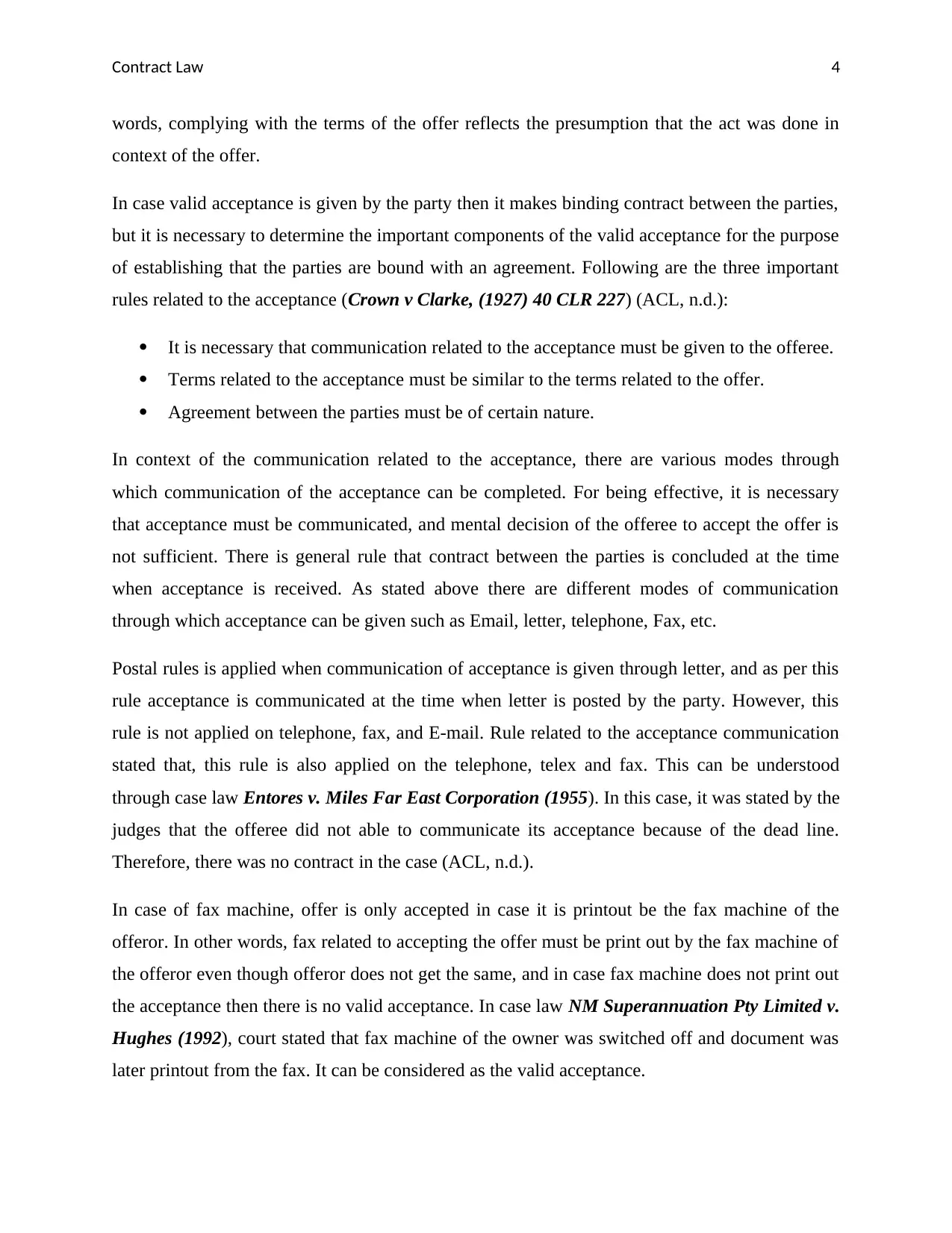
Contract Law 4
words, complying with the terms of the offer reflects the presumption that the act was done in
context of the offer.
In case valid acceptance is given by the party then it makes binding contract between the parties,
but it is necessary to determine the important components of the valid acceptance for the purpose
of establishing that the parties are bound with an agreement. Following are the three important
rules related to the acceptance (Crown v Clarke, (1927) 40 CLR 227) (ACL, n.d.):
It is necessary that communication related to the acceptance must be given to the offeree.
Terms related to the acceptance must be similar to the terms related to the offer.
Agreement between the parties must be of certain nature.
In context of the communication related to the acceptance, there are various modes through
which communication of the acceptance can be completed. For being effective, it is necessary
that acceptance must be communicated, and mental decision of the offeree to accept the offer is
not sufficient. There is general rule that contract between the parties is concluded at the time
when acceptance is received. As stated above there are different modes of communication
through which acceptance can be given such as Email, letter, telephone, Fax, etc.
Postal rules is applied when communication of acceptance is given through letter, and as per this
rule acceptance is communicated at the time when letter is posted by the party. However, this
rule is not applied on telephone, fax, and E-mail. Rule related to the acceptance communication
stated that, this rule is also applied on the telephone, telex and fax. This can be understood
through case law Entores v. Miles Far East Corporation (1955). In this case, it was stated by the
judges that the offeree did not able to communicate its acceptance because of the dead line.
Therefore, there was no contract in the case (ACL, n.d.).
In case of fax machine, offer is only accepted in case it is printout be the fax machine of the
offeror. In other words, fax related to accepting the offer must be print out by the fax machine of
the offeror even though offeror does not get the same, and in case fax machine does not print out
the acceptance then there is no valid acceptance. In case law NM Superannuation Pty Limited v.
Hughes (1992), court stated that fax machine of the owner was switched off and document was
later printout from the fax. It can be considered as the valid acceptance.
words, complying with the terms of the offer reflects the presumption that the act was done in
context of the offer.
In case valid acceptance is given by the party then it makes binding contract between the parties,
but it is necessary to determine the important components of the valid acceptance for the purpose
of establishing that the parties are bound with an agreement. Following are the three important
rules related to the acceptance (Crown v Clarke, (1927) 40 CLR 227) (ACL, n.d.):
It is necessary that communication related to the acceptance must be given to the offeree.
Terms related to the acceptance must be similar to the terms related to the offer.
Agreement between the parties must be of certain nature.
In context of the communication related to the acceptance, there are various modes through
which communication of the acceptance can be completed. For being effective, it is necessary
that acceptance must be communicated, and mental decision of the offeree to accept the offer is
not sufficient. There is general rule that contract between the parties is concluded at the time
when acceptance is received. As stated above there are different modes of communication
through which acceptance can be given such as Email, letter, telephone, Fax, etc.
Postal rules is applied when communication of acceptance is given through letter, and as per this
rule acceptance is communicated at the time when letter is posted by the party. However, this
rule is not applied on telephone, fax, and E-mail. Rule related to the acceptance communication
stated that, this rule is also applied on the telephone, telex and fax. This can be understood
through case law Entores v. Miles Far East Corporation (1955). In this case, it was stated by the
judges that the offeree did not able to communicate its acceptance because of the dead line.
Therefore, there was no contract in the case (ACL, n.d.).
In case of fax machine, offer is only accepted in case it is printout be the fax machine of the
offeror. In other words, fax related to accepting the offer must be print out by the fax machine of
the offeror even though offeror does not get the same, and in case fax machine does not print out
the acceptance then there is no valid acceptance. In case law NM Superannuation Pty Limited v.
Hughes (1992), court stated that fax machine of the owner was switched off and document was
later printout from the fax. It can be considered as the valid acceptance.
Paraphrase This Document
Need a fresh take? Get an instant paraphrase of this document with our AI Paraphraser
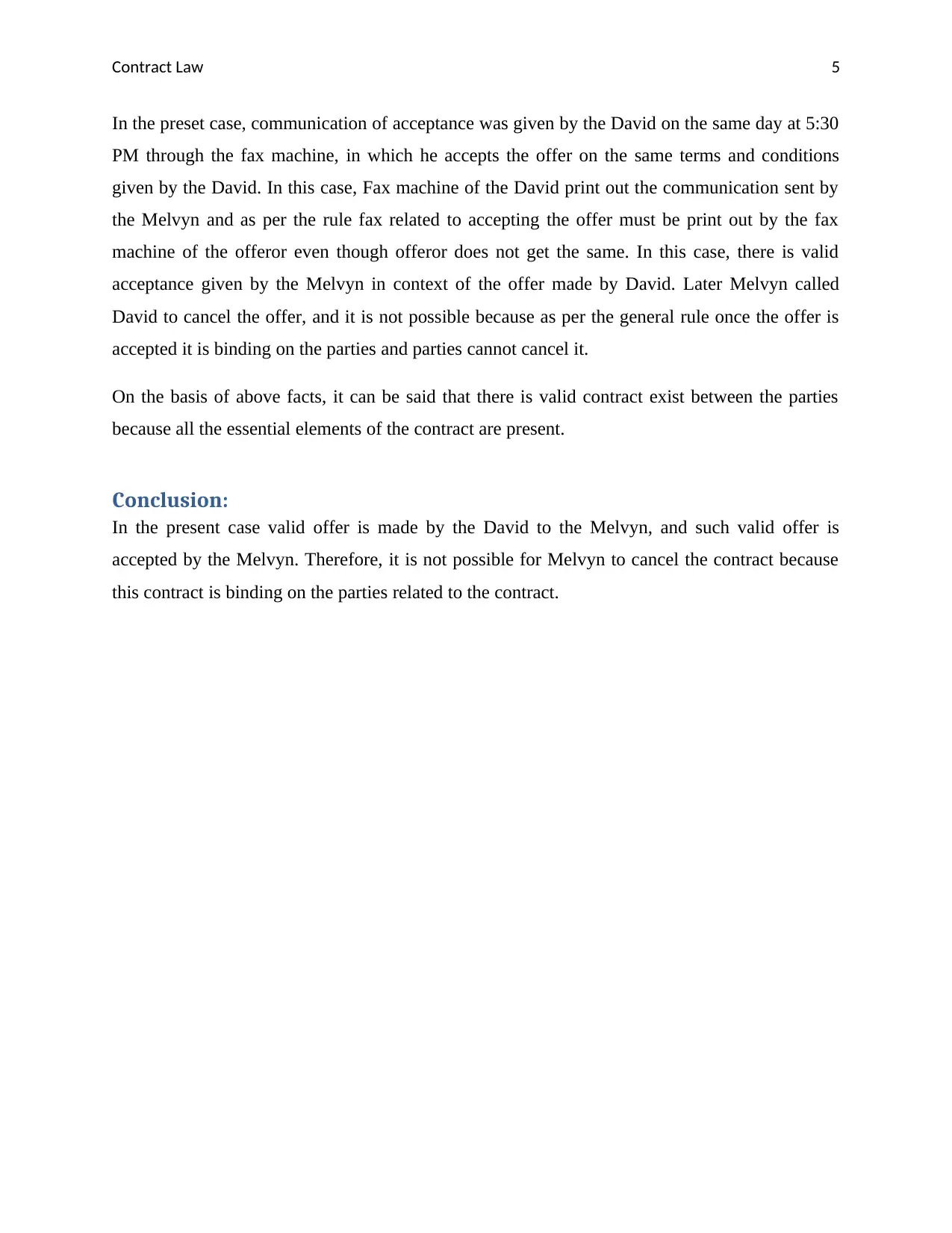
Contract Law 5
In the preset case, communication of acceptance was given by the David on the same day at 5:30
PM through the fax machine, in which he accepts the offer on the same terms and conditions
given by the David. In this case, Fax machine of the David print out the communication sent by
the Melvyn and as per the rule fax related to accepting the offer must be print out by the fax
machine of the offeror even though offeror does not get the same. In this case, there is valid
acceptance given by the Melvyn in context of the offer made by David. Later Melvyn called
David to cancel the offer, and it is not possible because as per the general rule once the offer is
accepted it is binding on the parties and parties cannot cancel it.
On the basis of above facts, it can be said that there is valid contract exist between the parties
because all the essential elements of the contract are present.
Conclusion:
In the present case valid offer is made by the David to the Melvyn, and such valid offer is
accepted by the Melvyn. Therefore, it is not possible for Melvyn to cancel the contract because
this contract is binding on the parties related to the contract.
In the preset case, communication of acceptance was given by the David on the same day at 5:30
PM through the fax machine, in which he accepts the offer on the same terms and conditions
given by the David. In this case, Fax machine of the David print out the communication sent by
the Melvyn and as per the rule fax related to accepting the offer must be print out by the fax
machine of the offeror even though offeror does not get the same. In this case, there is valid
acceptance given by the Melvyn in context of the offer made by David. Later Melvyn called
David to cancel the offer, and it is not possible because as per the general rule once the offer is
accepted it is binding on the parties and parties cannot cancel it.
On the basis of above facts, it can be said that there is valid contract exist between the parties
because all the essential elements of the contract are present.
Conclusion:
In the present case valid offer is made by the David to the Melvyn, and such valid offer is
accepted by the Melvyn. Therefore, it is not possible for Melvyn to cancel the contract because
this contract is binding on the parties related to the contract.
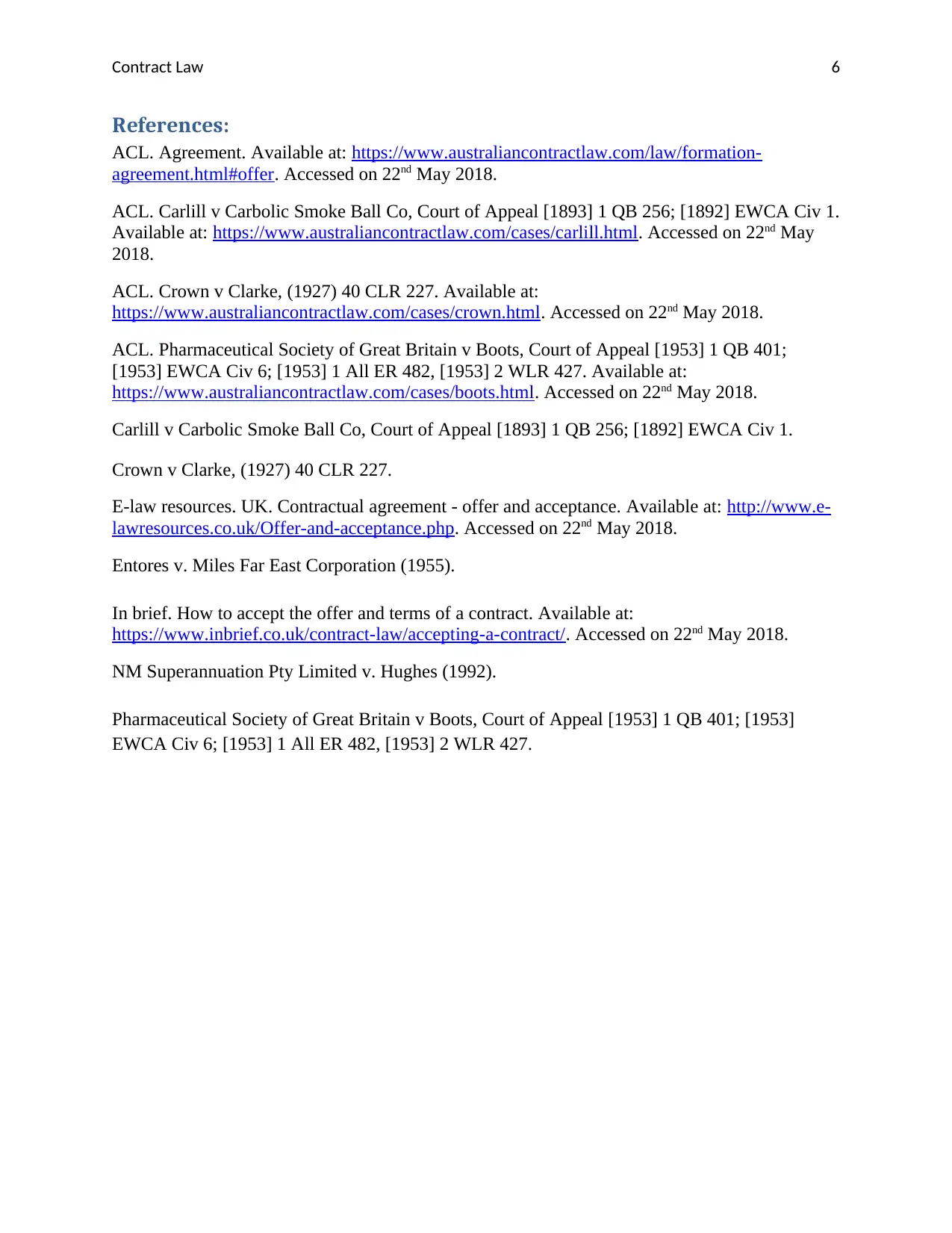
Contract Law 6
References:
ACL. Agreement. Available at: https://www.australiancontractlaw.com/law/formation-
agreement.html#offer. Accessed on 22nd May 2018.
ACL. Carlill v Carbolic Smoke Ball Co, Court of Appeal [1893] 1 QB 256; [1892] EWCA Civ 1.
Available at: https://www.australiancontractlaw.com/cases/carlill.html. Accessed on 22nd May
2018.
ACL. Crown v Clarke, (1927) 40 CLR 227. Available at:
https://www.australiancontractlaw.com/cases/crown.html. Accessed on 22nd May 2018.
ACL. Pharmaceutical Society of Great Britain v Boots, Court of Appeal [1953] 1 QB 401;
[1953] EWCA Civ 6; [1953] 1 All ER 482, [1953] 2 WLR 427. Available at:
https://www.australiancontractlaw.com/cases/boots.html. Accessed on 22nd May 2018.
Carlill v Carbolic Smoke Ball Co, Court of Appeal [1893] 1 QB 256; [1892] EWCA Civ 1.
Crown v Clarke, (1927) 40 CLR 227.
E-law resources. UK. Contractual agreement - offer and acceptance. Available at: http://www.e-
lawresources.co.uk/Offer-and-acceptance.php. Accessed on 22nd May 2018.
Entores v. Miles Far East Corporation (1955).
In brief. How to accept the offer and terms of a contract. Available at:
https://www.inbrief.co.uk/contract-law/accepting-a-contract/. Accessed on 22nd May 2018.
NM Superannuation Pty Limited v. Hughes (1992).
Pharmaceutical Society of Great Britain v Boots, Court of Appeal [1953] 1 QB 401; [1953]
EWCA Civ 6; [1953] 1 All ER 482, [1953] 2 WLR 427.
References:
ACL. Agreement. Available at: https://www.australiancontractlaw.com/law/formation-
agreement.html#offer. Accessed on 22nd May 2018.
ACL. Carlill v Carbolic Smoke Ball Co, Court of Appeal [1893] 1 QB 256; [1892] EWCA Civ 1.
Available at: https://www.australiancontractlaw.com/cases/carlill.html. Accessed on 22nd May
2018.
ACL. Crown v Clarke, (1927) 40 CLR 227. Available at:
https://www.australiancontractlaw.com/cases/crown.html. Accessed on 22nd May 2018.
ACL. Pharmaceutical Society of Great Britain v Boots, Court of Appeal [1953] 1 QB 401;
[1953] EWCA Civ 6; [1953] 1 All ER 482, [1953] 2 WLR 427. Available at:
https://www.australiancontractlaw.com/cases/boots.html. Accessed on 22nd May 2018.
Carlill v Carbolic Smoke Ball Co, Court of Appeal [1893] 1 QB 256; [1892] EWCA Civ 1.
Crown v Clarke, (1927) 40 CLR 227.
E-law resources. UK. Contractual agreement - offer and acceptance. Available at: http://www.e-
lawresources.co.uk/Offer-and-acceptance.php. Accessed on 22nd May 2018.
Entores v. Miles Far East Corporation (1955).
In brief. How to accept the offer and terms of a contract. Available at:
https://www.inbrief.co.uk/contract-law/accepting-a-contract/. Accessed on 22nd May 2018.
NM Superannuation Pty Limited v. Hughes (1992).
Pharmaceutical Society of Great Britain v Boots, Court of Appeal [1953] 1 QB 401; [1953]
EWCA Civ 6; [1953] 1 All ER 482, [1953] 2 WLR 427.
⊘ This is a preview!⊘
Do you want full access?
Subscribe today to unlock all pages.

Trusted by 1+ million students worldwide
1 out of 6
Related Documents
Your All-in-One AI-Powered Toolkit for Academic Success.
+13062052269
info@desklib.com
Available 24*7 on WhatsApp / Email
![[object Object]](/_next/static/media/star-bottom.7253800d.svg)
Unlock your academic potential
Copyright © 2020–2025 A2Z Services. All Rights Reserved. Developed and managed by ZUCOL.





